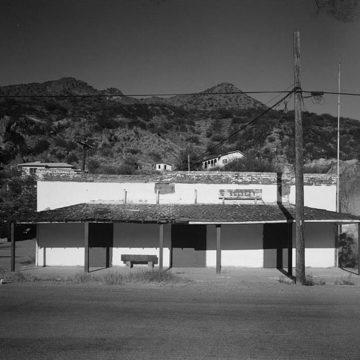You are here
La Casa Grande
By 1872, reports had reached Silver City, New Mexico, of potentially rich copper deposits some seventy miles to the west in Arizona Territory. This was enough to convince businessman Henry Lesinsky to acquire mining claims in the area. Within a year, he began crude mining and smelting operations at the confluence of Chase Creek and the San Francisco River, tapping the nearest sources of experienced labor—workers from Cananea and Nacozari in northern Mexico.
In 1874, Lesinsky and his workers built the mining camp’s first commercial building (and Lesinsky’s residence). “La Casa Grande,” as the locals called it, was on the east side of the river at the confluence with the creek. The first commercial center of the fledging copper camp grew up just to the south, while the smelting operations developed directly across the river to the west.
Lesinsky and his workers used the only available materials: with mud from the river’s edge, they made adobe bricks, fashioning them into parapet-topped walls; they also used mud for the roof, placing it atop log beams (vigas) with transecting sticks (latías) in the traditional Sonoran rowhouse configuration. The structure’s six rooms were divided by a central hall or zaguán running the length of the building.
After the Arizona Copper Company acquired Lesinsky’s holdings in 1883, the building served as offices and residence for M.J. Egan, the ACC’s legal advisor. The ACC later converted the building for use by the YMCA, which occupied it between 1917 and 1932. During this time, the building underwent numerous modifications and additions. The interior layout changed, some windows were in-filled, two feet of brick was added to the front parapet, and a lean-to porch or toldo, was extended across the main facade.
The building’s subsequent tenants have included the American Legion and the Greenlee County Historical Society. Over the years, La Casa Grande has survived numerous floods and while the devastation of 1983 rendered the building uninhabitable, it is, amazingly, still standing. It has remained vacant since then, although efforts are currently underway to return it to a usable condition. The building was individually listed in the National Register of Historic Places in 1979.
References
Patton, James M. History of Clifton. Clifton, AZ: Greenlee County Chamber of Commerce, 1977.
Philips, David A., and Harris Sobin. Clifton’s Historic Buildings: A Flood Control-Related Cultural Resources Study of Clifton, Greenlee County, Arizona.U.S. Army Corps of Engineers, 1985.
Ryden Architects, Inc. Clifton Townsite Historic American Buildings Survey, Vol. 2. U.S. Army Corps of Engineers, 1995.
Zindel, Udo. Landscape Evolution in the Clifton-Morenci Mining District, Arizona, 1872-1986.Master’s thesis, Arizona State University, 1987.
Writing Credits
If SAH Archipedia has been useful to you, please consider supporting it.
SAH Archipedia tells the story of the United States through its buildings, landscapes, and cities. This freely available resource empowers the public with authoritative knowledge that deepens their understanding and appreciation of the built environment. But the Society of Architectural Historians, which created SAH Archipedia with University of Virginia Press, needs your support to maintain the high-caliber research, writing, photography, cartography, editing, design, and programming that make SAH Archipedia a trusted online resource available to all who value the history of place, heritage tourism, and learning.












